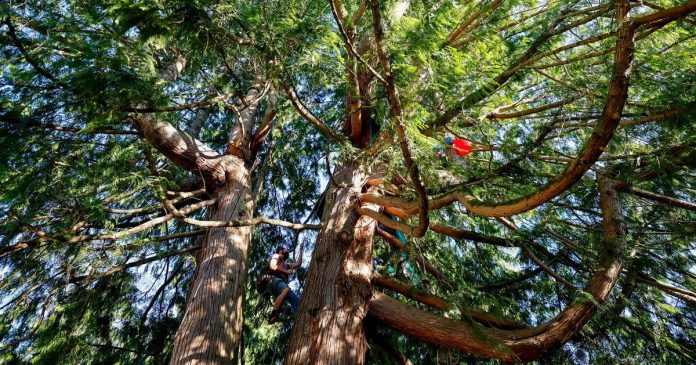A Bellevue-based real estate lending company has backed out of plans to remove a double-trunk Western red cedar in Wedgwood after pressure from the Snoqualmie Tribe, archaeologists and community members.
The tree on Northeast 88th Street has been at the center of the tribe and environmental activists’ battle against Legacy Group Capital’s plan to cut it down for the development of six housing units: two single-family homes with four accessory dwelling units.
Last month, the Washington State Department of Archaeology & Historic Preservation officially recorded the tree as a state archaeological site after an assessment concluded it was culturally modified by the Snoqualmie Tribe. Under Washington law, developers must get state permits before they can modify an archaeological site.
Culturally modified trees are part of an ancient Indigenous trail system connecting Puget Sound to Lake Washington. For thousands of years, the Snoqualmie people modified tree boughs to mark important locations along the trail and reach fishing, hunting and gathering places across the region.
Legacy Group Capital met with the Snoqualmie Tribe on Monday to better understand culturally modified trees, according to a Wednesday news release by the company. The release said the group will redesign the plan to build one or two units on the site.
The cedar, named “Luma” by community members, stands about 80 feet tall. Arborists estimate the cedar may be two centuries old based on its trunk size.
After multiple tree removal services backed out of the deal in July, the removal was stalled. Environmentalists wanted the city to spare the tree, but the city’s Department of Construction & Inspections said it had no legal authority to revoke a tree removal permit once one was approved and issued.
Community members gathered at the site several times, building flower petal mandalas and putting up signs bearing messages such as “Save Seattle Trees.” Activists, each of whom go by the name “Droplet,” have strapped themselves to the tree for four weeks.
New construction is one of the biggest causes of tree canopy loss, according to Seattle’s 2021 tree canopy assessment.
“We are excited Legacy Group Capital is making this commitment to cultural preservation and we look forward to working with them on developing a process for proactive … assessment during their feasibility process,” Jaime Martin, Snoqualmie Tribe executive director of governmental affairs and special projects, said in the news release.
Seattle Mayor Bruce Harrell and City Councilmember Dan Strauss are “exploring new regulations” to protect culturally modified trees, according to the release. A statement from Strauss said the city will consult with tribes before sharing more information about what the regulations will entail.
Martin said the tribe wants to ensure permitting departments and developers understand the importance of the issue, and that it’s critical the conversations happen in a meaningful and appropriate way so tribal rights are respected.
“Trees and housing are both critically important to Seattle’s future,” Harrell said in the news release. “Working together, I’m grateful for the collaborative approach embraced by the owner, builder, lender, and Snoqualmie Tribe to reach a solution preserving this Culturally Modified Tree and allowing for much needed housing. We look forward to continued partnership with Tribes and regional Native leaders to identify and protect Culturally Modified Trees in our city.”
Tree Action Seattle, a tree advocacy group, celebrated the decision but said maintaining trees doesn’t have to mean reducing housing, and independent assessments found there could have been six units alongside the tree.
“In this case, the developer has decided to subscribe to the false dichotomy of ‘housing versus trees,’ when we know that such a forced choice is not necessary in almost all cases where infill housing is being created within an existing lot,” Tree Action Seattle said in a news release.
City Councilmember Alex Pedersen, whose district encompasses the tree, said in a statement that the city has more work to do to improve tree protections.
“I want to thank Mayor Harrell and all those who took actions to save this exceptional tree, including the tree advocates and Tribal Governments who understand that mature trees provide valuable public health benefits, environmental sustainability, and deep cultural significance,” Pedersen said, “and we must do more to save more of these trees in the face of increasing urban heat from the increasing climate crisis.”
One of the activists named Droplet is now considering vacating the tree in the next few days. But the activists want broader change — and are willing to climb up other trees at risk of removal.
“Any tree ordinance, past or present, that would allow this tree to be cut, clearly is not serving the people of Seattle,” one of the activists said Wednesday.
Tree conservation groups in the city are still fighting against Seattle’s new tree code, which went into effect July 30. The code requires builders who remove trees with a diameter of 2 feet or greater to either replace the tree on-site or pay into the city’s tree fund for each tree that is removed, and plant additional trees in the right of way.
But environmental activists say the new code will allow even more trees to be removed, and planting saplings doesn’t provide the same benefits as preserving large trees. Large trees sequester more carbon than younger, smaller trees.
The Master Builders Association of King and Snohomish Counties, one of the region’s largest development voices, celebrated the new legislation.
Tree Action Seattle described the saving of Luma as the “first step on a long road to climate justice that we envision for all of Seattle and our region.”
“We must continue to advocate for both housing and trees in this age of unchecked climate crisis,” Tree Action Seattle said in the release. “We can — and must — grow with our trees.”
www.seattletimes.com
https://www.seattletimes.com/seattle-news/environment/developer-abandons-plan-to-cut-down-wedgwood-tree/















